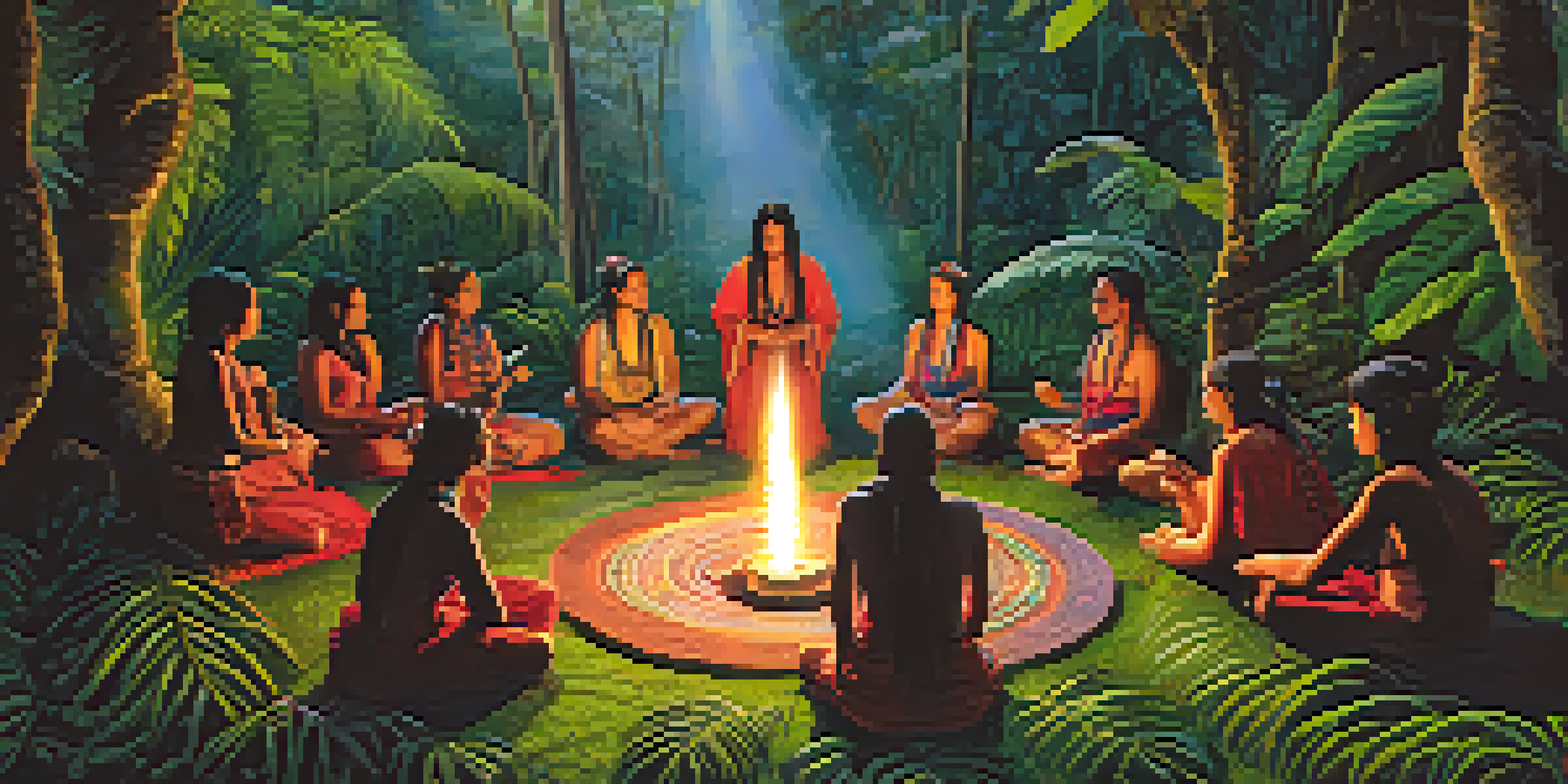The Role of Music and Sound in Ayahuasca Consciousness Shifts

Understanding Ayahuasca and Its Transformative Powers
Ayahuasca is a powerful plant medicine traditionally used in South American shamanic practices. It consists mainly of two plants: the Banisteriopsis caapi vine and the Psychotria viridis leaf. When consumed, it induces profound altered states of consciousness, often leading to insights, healing, and personal transformation.
Music is the shorthand of emotion.
For many, the experience can be intense and challenging, as the brew can evoke strong emotions and visions. This is where the supportive elements of the ceremony, like music and sound, play a crucial role. They serve to guide participants through the often turbulent waters of their inner journey.
Understanding the significance of Ayahuasca is essential for fully appreciating how music and sound can enhance the experience. As participants navigate their emotional landscapes, these auditory elements can help create a safe and nurturing environment.
The Role of Music in Ayahuasca Ceremonies
Music is a cornerstone of Ayahuasca ceremonies, often performed by the shaman or healer leading the session. This music, typically consisting of traditional songs known as 'icaros,' is specifically designed to align with the energy of the ceremony. Each icaros carries a unique vibration and intention, guiding participants through their experiences.

The melodies and rhythms of the music can evoke deep emotional responses, helping participants process their feelings and memories. Moreover, the repetitive nature of certain sounds can create a trance-like state, allowing individuals to delve deeper into their subconscious. Essentially, music acts as a vessel for healing and transformation.
Power of Music in Healing
Music, particularly traditional icaros, plays a crucial role in guiding participants through their Ayahuasca experiences, fostering healing and transformation.
In many cases, the choice of music can significantly influence the overall atmosphere of the ceremony. A calm, soothing melody may promote relaxation, while a more intense rhythm can energize or challenge participants, encouraging them to confront difficult emotions.
How Sound Shapes the Ayahuasca Experience
Sound, much like music, plays a vital role in shaping the Ayahuasca experience. From the sounds of nature to the shaman's voice, each auditory element contributes to the overall ambiance. These sounds can evoke feelings of safety and connection, enhancing participants' ability to surrender to the experience.
The sound of the world is a gift, a language of its own that speaks to the soul.
The connection between sound and consciousness is profound; certain frequencies can resonate with the body's energy centers, also known as chakras. As participants undergo emotional and spiritual release, these sounds can help facilitate healing on a physical and energetic level. This interaction can amplify the effects of the Ayahuasca journey.
Moreover, participants often report that specific sounds can trigger vivid memories or insights. This highlights the powerful interplay between sound and consciousness, as certain auditory cues can unlock deeper layers of understanding during the journey.
The Shaman's Role in Guiding Through Sound
The shaman serves as a guide during the Ayahuasca ceremony, using music and sound to steer participants through their experiences. Their deep understanding of the plant medicine and its effects allows them to select the appropriate songs and sounds at each moment. This ensures that the energy remains aligned with the participants' journeys.
In many ways, a shaman's voice is an anchor during the ceremony. The soothing tones and intentional lyrics can help ground participants when the experience becomes overwhelming. This guidance fosters a sense of safety, allowing individuals to explore their consciousness without fear.
Importance of Silence
Moments of silence during Ayahuasca ceremonies allow for deep introspection and integration of experiences, enhancing the overall journey.
The relationship between the shaman and the participants is built on trust and respect, further amplified through sound. As the shaman skillfully weaves music and intention, they create a shared space for healing and transformation, making sound an essential part of the Ayahuasca experience.
Cultural Significance of Music in Ayahuasca Practices
Music in Ayahuasca ceremonies is deeply rooted in cultural traditions, reflecting the beliefs and values of indigenous communities. These communities have long understood the importance of sound in spiritual practices, using it to connect with the divine and the natural world. The incorporation of music is not merely for entertainment but serves a profound purpose.
The icaros, for instance, are not just songs; they hold sacred meanings and stories passed down through generations. These songs often embody the spirit of the plants and the wisdom of the ancestors, creating a bridge between the physical and spiritual realms. This cultural context enriches the Ayahuasca experience, offering participants a deeper understanding of their journey.
Moreover, as Ayahuasca becomes more popular globally, the fusion of different musical styles is emerging. This evolution reflects a growing appreciation for the cultural significance of music while also allowing for personal expression and connection during ceremonies.
The Impact of Silence in Ayahuasca Ceremonies
While music and sound play pivotal roles in Ayahuasca ceremonies, silence is equally significant. Moments of silence allow participants to reflect and integrate their experiences, fostering deeper introspection. This pause can create space for insights to emerge, allowing individuals to process their emotions and thoughts more fully.
In fact, many participants describe these silent moments as profoundly powerful. They often find that during these times, they can connect more deeply with their inner selves and the wisdom of the universe. Silence can serve as a backdrop against which the music and sounds are more impactful, highlighting their significance.
Shaman's Guiding Role
The shaman's use of music and sound creates a nurturing environment, helping participants feel safe as they navigate their emotional journeys.
Ultimately, the balance of sound and silence creates a dynamic interplay that enriches the Ayahuasca experience. This rhythm of auditory stimulation and quiet reflection allows participants to journey through their consciousness in a holistic and integrated manner.
Personal Testimonials: The Power of Music and Sound
Many participants of Ayahuasca ceremonies have shared transformative stories about the impact of music and sound on their journeys. For some, specific icaros have evoked memories of childhood, allowing them to confront unresolved emotions. These moments underscore the profound connection between sound and personal healing.
Others have described how the shaman's voice guided them through intense emotional experiences, providing comfort and reassurance. This highlights the importance of the shaman's role in using sound to create a nurturing environment. The stories often reflect a common theme: music and sound can unlock the door to profound insights.

These personal testimonials not only illustrate the power of music and sound in Ayahuasca ceremonies but also emphasize the importance of preparation and intention. As participants approach their journeys, being open to the auditory elements can significantly enhance their overall experience.